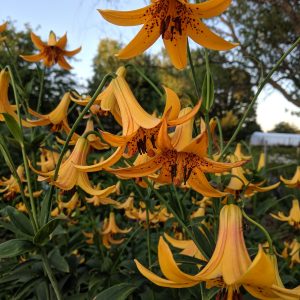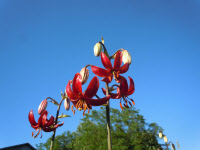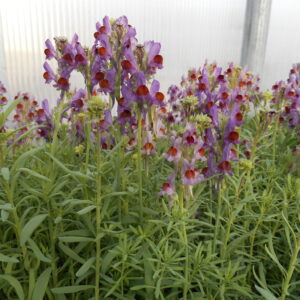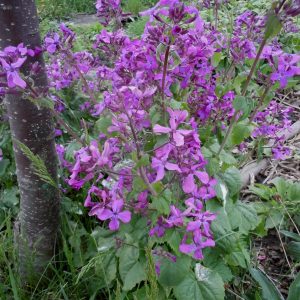Plants for Butterflies and Other Pollinators
Showing 113–120 of 223 results
-
Lilium canadense, Z 2-6
Showy, drooping bell-shaped flowers from lemon to dark orange in color with conspicuous red spots on the inside
OUT OF STOCK
Showy, drooping flowers from lemon to dark orange in color with conspicuous red spots on the inside.
Size: 2-4’ x 6”
Care: part shade in moist to moist well-drained, slightly acidic soil
Native: Upper Great Lakes & southern Canada
Wildlife Value: attracts butterfliesIntroduced to gardens from its native North America by Jacques Cartier, 1535. Also collected by Swedish botanist Pehr Kalm (1716-1779) who collected in Northeastern US and SE Canada and sent it to Linnaeus. Grown at America’s 1st botanic garden, Elgin Botanic Garden 1811. Listed in the 1873 catalog of Leichtlin’schen Gartens in Baden-Baden.
-
Lilium martagon Martagon lily Z 3-8
Usually pink to carmine, smallish downfacing, reflexed petals, with one stem baring up to 50 individual flowers on mature plant.
Usually pink to carmine, smallish downfacing, reflexed petals, with one stem baring up to 50 individual flowers on mature plant.
Size: 3-6’ x 8-12”
Care: part shade to sun (shorter in sun) in well-drained, lime soil. Resents being moved & often will not emerge in 1st year.
Native: Eastern France to Korea.
Awards: Royal Horticultural Society Award of Merit; Elisabeth C. Miller Botanic Garden Great Plant Pick.The name Martagon means cap in Turkish from the style of turban adopted by Turkish ruler, Sultan Mohammed, which was known as a martagon and had a similarly pendulous shape. Described by English herbalist Gerard (1545-1612) in 1596.
-
Linaria alpina Alpine toadflax Z 5-8
Purple snapdragon-like petals bloom all summer and show off golden-orange lips
OUT OF STOCK
Purple snapdragon-like petals bloom all summer and show off golden-orange lips
Size: 4-6” x 6-12”
Care: sun in well-drained soil
Native: Mountains of central and southern EuropeListed in Gardeners Dictionary, 1768. Wm Robinson in July 1872 issue of The Garden: “The alpine Linaria is never more beautiful than when self-sown in a gravel walk.” January 1876 bloomed for 4+ months in the rock garden at Edinburgh Botanic Garden.
-
Liriodendron tulipfera Tulip tree Z 4-9
Large tulip-shaped yellow-green petals surround orange corolla, Ornamental leaves turn yellow in fall
Large tulip-shaped yellow-green petals surround orange corolla, Ornamental leaves turn yellow in fall
Size: 80-100’ x 30’
Care: sun in well drained to moist well drained soil. Fast growing and strong wood.
Native: New England to FL, Ontario to IL, south to Louisiana and all states in between.
Wildlife Value: attracts Tiger swallowtail butterfly.
Awards: Recipient Great Plant Pick Award from Elizabeth Carey Miller Botanical Garden & England’s Royal Horticultural Society Award of Merit & Great Plants for Great PlainsOne of the oldest flowering trees – about 95 million years old. Cherokee cured pinworms, cholera, dysentery, coughs, wounds, boils, fever, bone fractures, indigestion, snakebites, and “women with hysterics” with Tulip tree. Because it is light weight but strong, they made canoes for up to 20 people with Tulip tree wood. The Rappahannock chewed the bark as a stimulant for sex. Sent to Europe by Tradescant the Younger (1608-1662) before 1640. Grown by Jefferson. Washington planted them as an allée around the serpentine bowling green at Mount Vernon.
**LISTED AS OUT OF STOCK BECAUSE WE DO NOT SHIP THIS ITEM. IT IS AVAILABLE FOR PURCHASE AT OUR RETAIL LOCATION.
-
Lobelia cardinalis Cardinal flower Z 3-9
Ruby, cardinal red tubes with an upper lip split in half and a lower lip like a pixie’s apron encircle the spike up and down from August to October beckon hummingbirds to feed.
Ruby, cardinal red tubes with an upper lip split in half and a lower lip like a pixie’s apron encircle the spike up and down from August to October beckon hummingbirds to feed.
Size: 3’ x 12”
Care: sun to part shade in fertile, moist soil. Moist soil important
Native: Canada to Texas, Wisconsin native.
Wildlife Value: attracts hummingbirds
Awards: Received England’s Royal Horticultural Society Award of Merit & Missouri Botanic Garden Plant of Merit.Lobelia is named for Matthias L’Obel (1538-1616) French expatriate who immigrated to England and became physician to King James I. Cherokee cured stomach aches, worms, pain, fever, nose bleeds, rheumatism, headaches, colds and croup with Lobelia. They used the root to treat syphilis. In 1749 Swedish botanist Peter Kalm wrote that Indians used five species of Lobelia to cure venereal disease, “an infallible art of curing it.” Other Natives and colonists used the plant to induce vomiting. At the end of a funeral, Meskwaki Indians threw the dried and pulverized plant into the grave. Meskwaki also chopped the roots and secretly put it in the food of “a quarrelsome pair.” Allegedly “this makes the pair love each other again.” Tradescant the Younger (1608-1662) introduced this to European gardens when he sent it to England in 1637. Offered for sale in Bartram Garden’s 1783 Broadside. Grown by Washington at Mount Vernon and Thomas Jefferson at Monticello. Pressed specimen in Emily Dickinson’s herbarium.
-
Lobelia siphilitica ‘Alba’ z 4-8
Striking, erect spike of pure ivory blossoms opening from bottom up. On top club-shaped buds, below trumpet-shapes made of a tube flaring open at the ends with the top of the flare looking like a quarter moon with the circle at the bottom and the lower divided into three, each segment pointed at the ends. Its fresh white blooms stand out in late summer to early fall.
OUT OF STOCK
Striking, erect spike of pure ivory blossoms opening from bottom up. On top club-shaped buds, below trumpet-shapes made of a tube flaring open at the ends with the top of the flare looking like a quarter moon with the circle at the bottom and the lower divided into three, each segment pointed at the ends. Its fresh white blooms stand out in late summer to early fall.
Size: 2-3’ x 1-2’
Care: sun to part shade in moist or moist well-drained soil
Wildlife Value: Deer resistant, attracts bees, hummingbirds and some butterflies.This white one is “An albino of occasional occurrence.” Britton, Nathaniel Lord “On the Naming of ‘Forms,’ in the New Jersey Catalogue” Bulletin of the Torrey Botanical Club 17: 121,125. 1890. This may, therefore, be native in the same locations as the blue species or it may not.
-
Lobelia siphilitica Great lobelia Z 4-9
A striking, erect spike of sky to blueberry-blue blossoms. On top club-shaped buds, below trumpet-shaped, open flowers, made of a tube flaring open with the bottom divided into three, each segment pointed at the ends. From late summer to early fall.
A striking, erect spike of sky to blueberry-blue blossoms. On top club-shaped buds, below trumpet-shaped, open flowers, made of a tube flaring open with the bottom divided into three, each segment pointed at the ends. From late summer to early fall.
Size: 3' x 12"
Care: Full sun to part shade in moist to moist well-drained soil
Native: Connecticut to Wyoming, south to Texas then east to Georgia and all states in between, Wisconsin native.
Wildlife Value: attracts bumble bees, hummingbirds and some butterfliesLobelia is named for Matthias L’Obel (1538-1616) a French expatriate who emigrated to England and became physician to English King James I. Oneidas considered this good medicine for distemper. Sioux treated bloat, diarrhea and dysentery as well as a love charm by adding powdered root to the food of the intended. Cherokee used the root to treat headaches, stomachaches, worms, nosebleeds, colds and syphilis. 1st collected by Rev. John Banister (1649-1692) who moved to colonial Virginia in 1678. A gunman mistakenly shot and killed him while he collected plants. In 1749 Swedish botanist Peter Kalm wrote that Natives used five species of Lobelia to cure venereal disease, having “an infallible art of curing it.” According to John Bartram (1699-17760) “The learned Pehr Kalm (who gained the Knowledge of it from Colonel Johnson, who learned it of the Indians, who, after great Rewards bestowed on several of them, revealed the Secret to him) saith, That the Roots of this Plant cureth the Pox much more perfectly and easily than any mercurial Preparations, and is generally used by the Canada Indians, for the Cure of themselves.” (Better than mercury!) Offered for sale in Bartram Garden’s 1783 Broadside, America’s 1st plant catalog.
-
Lunaria annua Money plant, Honesty, Silver dollar Biennial Reseeds Z 5-10
Mauve phlox-like blooms spring to early summer turn into silvery, translucent seedpods.
Mauve phlox-like blooms spring to early summer turn into silvery, translucent seedpods.
LIMITED QUANTITIES AVAILABLE, LIMIT OF 1 PER CUSTOMER PLEASE.
Size: 1'-3' x 1’
Care: Full sun to part shade.
Native: mountains of Italy
Wildlife Value: attracts bees and butterfliesOld-fashioned heirloom. Silver dollars are perfect for dried bouquets! Popular in winter flower arrangements since colonial times. Introduced to England from Germany in the late 1500’s and carried to America by the Puritans as a reminder of home. Grown at America’s 1st botanic garden, Elgin Botanic Garden 1811.
**LISTED AS OUT OF STOCK BECAUSE WE DO NOT SHIP THIS ITEM. IT IS AVAILABLE FOR PURCHASE AT OUR RETAIL LOCATION.







